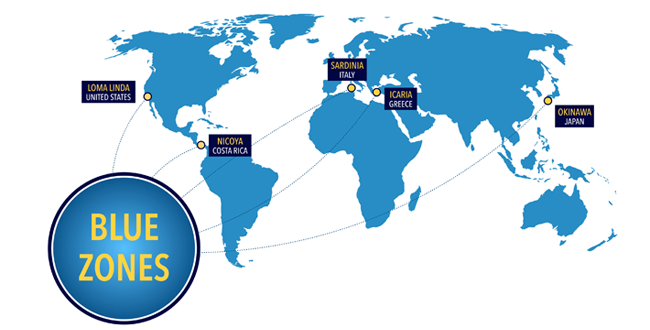On the trail of the secret of long life

What do a Japanese village, villages in Sardinia or a small town in California have in common? An astonishing number of people in these places enjoy a special longevity! It all began in 2000 with the Belgian demographer Michel Poulain and the Italian physician Gianni Pes.
The "Blue Zones" - places of centenarians
The two scientists researched the high number of centenarians in Sardinia. They drew ever closer blue circles on maps to reveal the places with the highest life expectancy. This is how the first "Blue Zone" was determined. A few years later, the US journalist Dan Buettner joined them: Together, they applied the term to other areas with particularly long-lived inhabitants. Buettner's cover story in National Geographic drew the world's attention to the "Blue Zones". Since then, he has traveled to and explored many regions and published several books on their "secrets".
The "hotspots" he has found so far:
- Sardinia, especially certain municipalities in the province of Ogliastra
- The Japanese island of Okinawa, in particular the village of Ogimi
- The small Californian town of Loma Linda
- The Nicoya Peninsula in Costa Rica
- The Greek island of Ikaria
Each Blue Zone has its own special features, for example in terms of culture or genetics. Think of the Japanese philosophy of Ikigai or the gene marker M26, which is more common in Sardinia and results in ten times as many centenarians as in the USA. The people there benefit from very similar lifestyles, including above all
- a predominantly plant-based diet
- moderate but constant physical activity
- cultural or geographical remoteness
- regular interpersonal contact
Eat better, live longer?
Can we copy the recipe for success for ourselves? It is true that we have no influence on certain factors such as life-extending genetic mutations, which, for example, remain limited on an island. However, the diet of centenarians in particular provides us with valuable clues. The secret lies not in the local ingredients, but in their properties. Nutrients that promote cell protection are central to this.
Vitamins A, C and E are particularly worth mentioning. They help to protect the cells from oxidative stress. They are found in fruit and vegetables as well as in vegetable oils and nuts. Similar to vitamins, flavonoids play a role in numerous metabolic processes. Several studies have investigated the effects of oligomeric procyanidins, or OPC for short, on cell protection. Selected trace elements such as zinc and selenium also contribute to protection against oxidative stress. But what is it all about?
This is caused by an increased proportion of free radicals in the body. They are produced by natural processes, but can also be caused by external influences such as UV radiation or tobacco consumption. These unstable oxygen compounds are very reactive and split off electrons from other cells, which leads to oxidation - and, in the worst case, results in cell damage or metabolic disorders.
Small steps with a big effect
Let's summarize: No one needs to emigrate to a Blue Zone to achieve a better or even longer life. If you exercise regularly, cultivate your relationships with family, friends and neighbors and pay attention to a nutrient-rich diet, you are already moving in the right direction. GSE is happy to support you with high-quality organic products whose ingredients can counteract oxidative stress: OPC Cell Protection Complex, Zinc + Vitamin Complex or Astaxanthin + Selenium.
Sources:
1. Blue Zones, Wikipedia article
2 Dan Buettner: Blue Zones: Lessons For Living Longer From The People Who've Lived The Longest (2008).
3. Blue Zone Sardinia (English)



